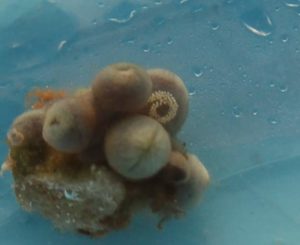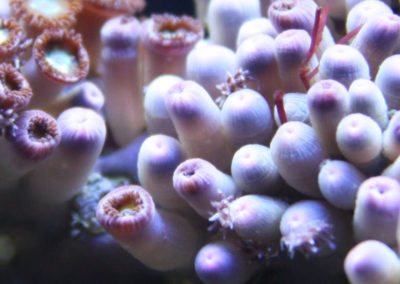Introduction to Zoanthid Eating Nudibranchs:
Zoanthid Eating Nudibranchs also are known as Zoa Eating Nudibranchs or Zoo Eating Nudibranchs are a type of aeolid nudibranchs which are known to feed on coral.
It is important to keep these parasites out of our aquaria. Zoanthid Eating Nudibranchs seem to eat Zoanthid polyps while they appear to have little or no effect on Protopalythoa or Palythoa species.
It is easy for an aquarist to confuse Zoanthid species with Palythoa and Protopalythoa species. If you are unsure of what you have, use a book such as Julian Sprung’s book, Invertebrates: A Quick Reference Guide.
Even if you think that you know what type of polyp you are dealing with, you might want to check this book just to be certain.
What Zoanthid Eating Nudibranchs look like:
Zoanthid Eating Nudibranchs are brown and frilly and grow to about 1/2 inch in length.

Life Cycle:
Eggs are laid in a circular pattern as shown below.
These nudibranchs are thought to be asexual, not needing another nudibranch to reproduce.

Prevention:
A quarantine tank is the easiest way to prevent these ugly little reef critters from destroying your Zoanthid based reef tank. Ideally, Zoanthid corals should be left in quarantine for 3 months.
During the quarantine time, you should view the coral on a daily basis and watch for Nudibranchs or eggs. Remember that Zoa Eating Nudibranchs like to stay hidden in the polyp mat.
Whether or not quarantine is an option, a dip in CoralRx is highly suggested.
Treatment:
Treatment should be done in a quarantine tank.
- The first step is to move the affected corals to a quarantine tank; the quarantine tank should have good light and water flow.
- Next, take your coral out of the main tank and dip it in Coral Rx. While the coral is in CoralRx take a turkey baster, and blast the coral with the dip. Making sure it is getting in between the polyps and the underside of the coral. Do this for approximately 5 – 10 minutes.
- After 5 – 10 minutes, remove coral and discard the coral dip. Do not reuse the coral dip as parasites may release toxins.
- Rinse coral with clean saltwater and return to the quarantine tank. Repeat every 4-8 days till no more nudibranchs are found. Leave the coral in your quarantine system for an additional 3 months before moving back to your aquarium. Additionally, adding wrasses to your quarantine tank will also aid in the treatment of Zoanthid-Eating Nudibranchs.








